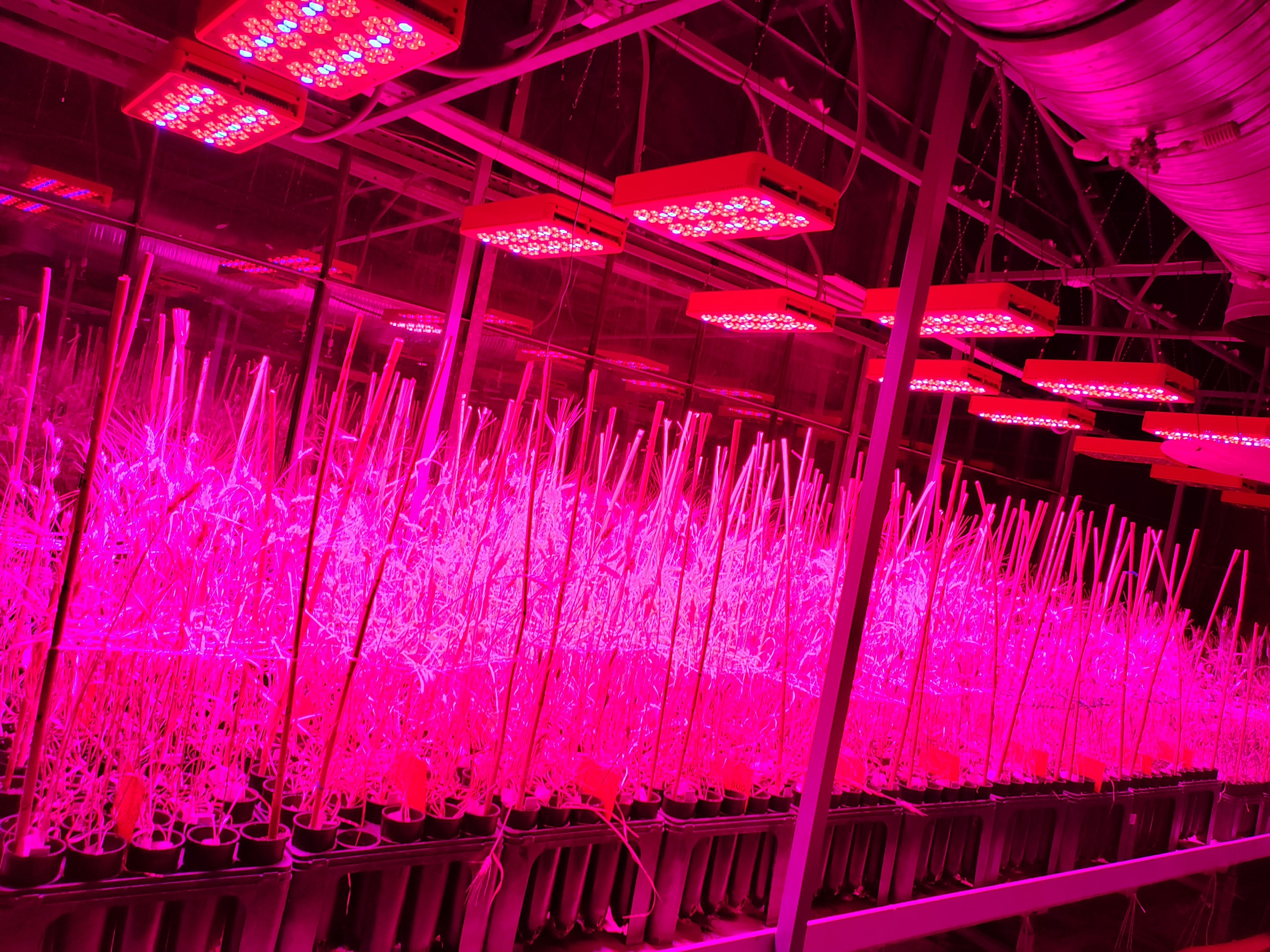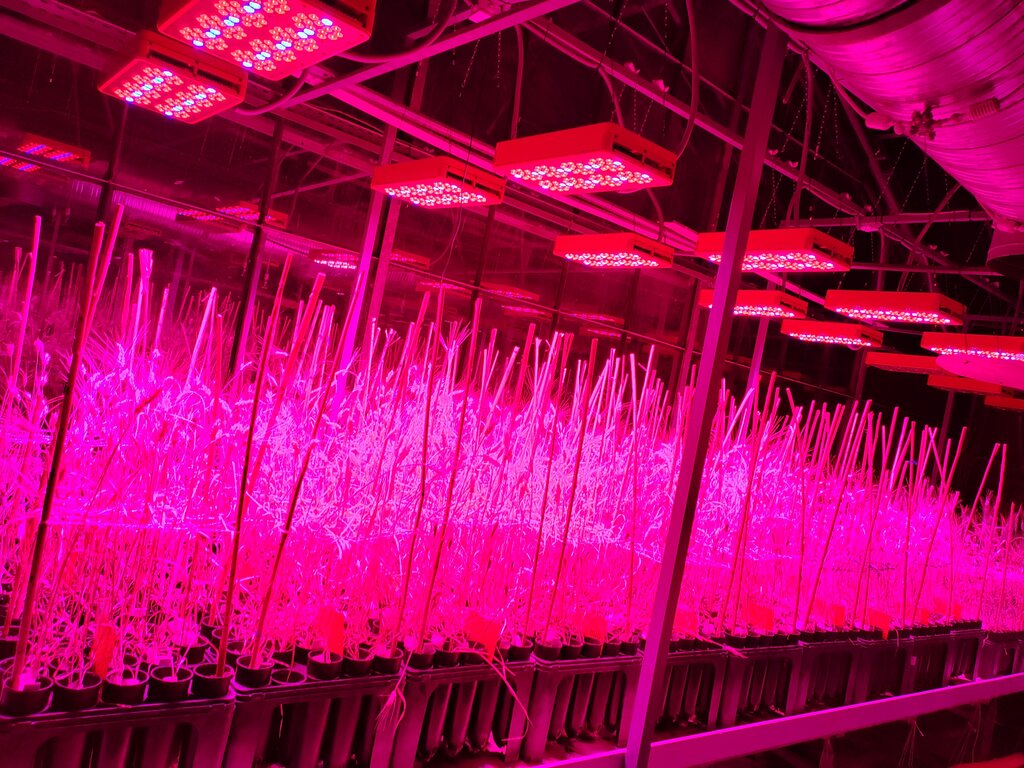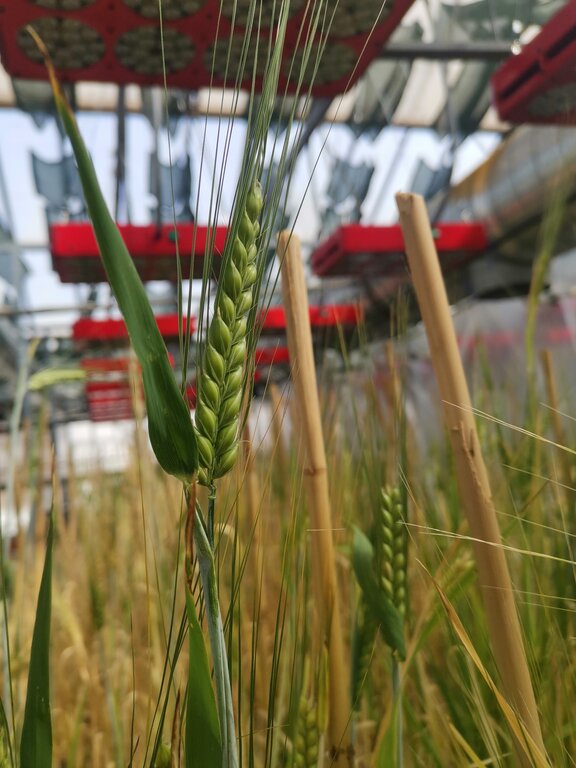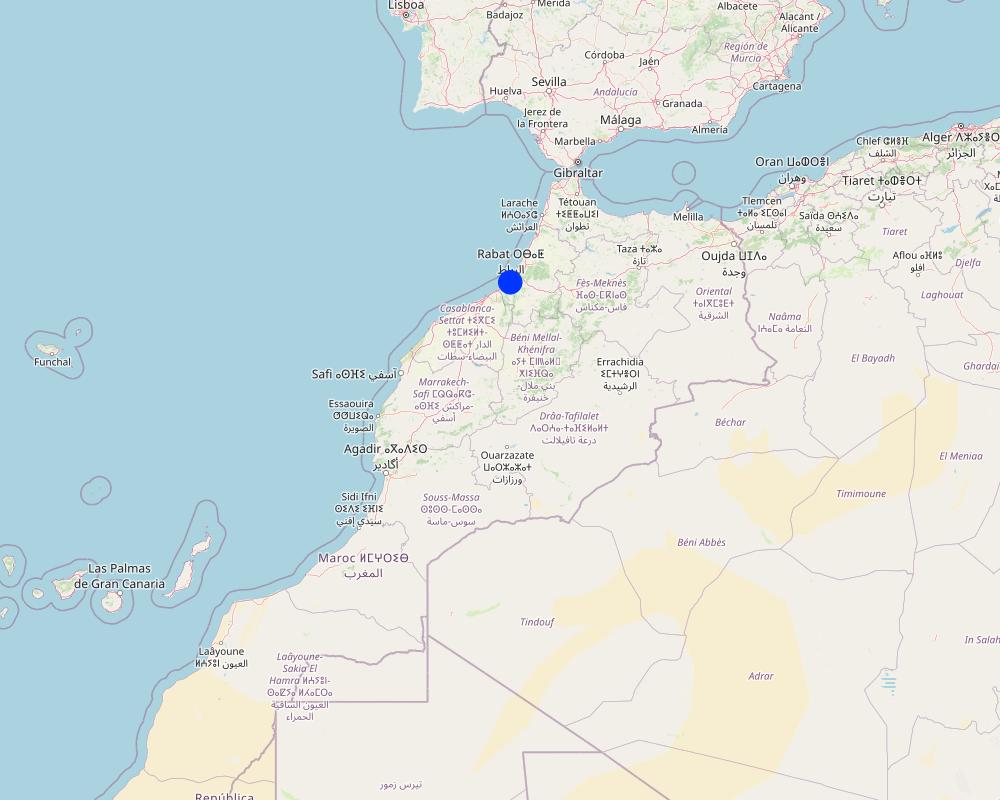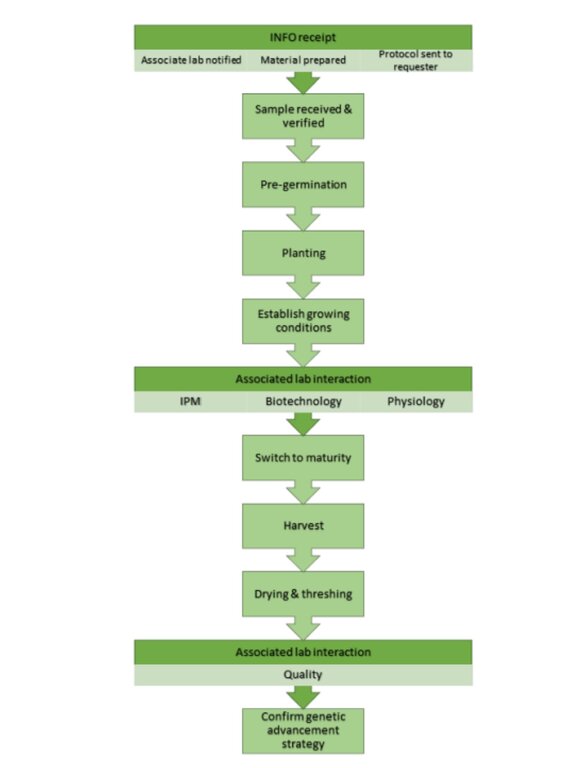Speed Breeding Platform [Maroc]
- Création :
- Mise à jour :
- Compilateur : Joren Verbist
- Rédacteur : –
- Examinateurs : William Critchley, Rima Mekdaschi Studer
approaches_6875 - Maroc
Voir les sections
Développer tout Réduire tout1. Informations générales
1.2 Coordonnées des personnes-ressources et des institutions impliquées dans l'évaluation et la documentation de l'Approche
Personne(s) ressource(s) clé(s)
Developed the Standard Operating Procedures of ICARDA Speed Breeding Platform:
Zaim M
International Center of Agricultural Research in Dry Areas (ICARDA)
Maroc
Speed Breeding Platform co-developer:
Morsli H
International Center of Agriculture Research in the Dry Areas (ICARDA)
Maroc
Physiologist:
Visioni M
International Center of Agricultural Research in Dry Areas (ICARDA)
Maroc
Entomologist:
Boulamtat R
International Center of Agricultural Research in Dry Areas (ICARDA)
Maroc
Pathologist:
Kemal S.A.
Maroc
Barley Breeder and Speed Breeding Platform designer:
Sanchez-Garcia M
International Center of Agricultural Research in Dry Areas (ICARDA)
Maroc
Nom du projet qui a facilité la documentation/ l'évaluation de l'Approche (si pertinent)
ICARDA Institutional Knowledge Management InitiativeNom du ou des institutions qui ont facilité la documentation/ l'évaluation de l'Approche (si pertinent)
International Center for Agricultural Research in the Dry Areas (ICARDA) - Liban1.3 Conditions relatives à l'utilisation par WOCAT des données documentées
Quand les données ont-elles été compilées (sur le terrain)?
2022
Le compilateur et la(les) personne(s) ressource(s) acceptent les conditions relatives à l'utilisation par WOCAT des données documentées:
Oui
2. Description de l'Approche de GDT
2.1 Courte description de l'Approche
Improving crop varieties is crucial for food security and climate resilience, but traditional methods are slow and expensive. The Speed Breeding Platform shortens breeding time substantially, enhances quality, and relies on strong partnerships between NARES and CGIAR centers.
2.2 Description détaillée de l'Approche
Description détaillée de l'Approche:
Climate change presents significant challenges for agriculture and crop production. One possible solution to enhance climate resilience is the development and adoption of improved, better adapted crop varieties. These varieties are specifically engineered to withstand specific threats, offering farmers a more reliable means of ensuring successful harvests despite the challenges posed by a changing climate. Improved varieties are thus crucial for achieving food security.
However, a major limitation of this solution is that researching and producing new crop varieties is a complex process that demands considerable time and resources. It involves cross design, segregating generation advancement and rigorous field testing to identify traits. The development of new varieties often spans several years, if not decades, before they are ready for widespread adoption by farmers. Sustained investment and collaboration across scientific organizations are thus crucial.
To accelerate the development of improved crop varieties, the International Center of Agricultural Research in Dry Areas (ICARDA), together with partners is implementing Speed Breeding as its main generation advancement method. Through the support of the Arab Fund for Economic and Social development (AFESD), the Templeton World Charity Foundation, Inc and the Crop Trust, protocols to accelerate the generation advancement of the main crops (wheat, barley, faba bean, lentil, grasspea and chickpea) have been developed and are available to NARES. ICARDA has also established the Speed Breeding Platform in Rabat, Morocco. Covering approximately 500 square meters, this facility comprises four buildings, including two greenhouses of 175 m2 and 185 m2 respectively, each housing five independently controlled growth chamber.i
The Speed Breeding method utilises LED lighting - originally invented by NASA to sustain astronauts during prolonged space missions to compensate for the absence of sunlight in space. By providing plants with approximately 22 hours of light per day, this accelerates their growth significantly. Cultivating crops in a controlled environment shields them from the unpredictable impacts of adverse weather conditions. The major advantage is thus its ability to accelerate the breeding process for improved crop varieties. For instance, while traditional methods may take between 6 and 12 years to breed a new grass pea (Lathyrus sativus) variety, utilizing the Speed Breeding Platform reduces this timeframe to approximately 5 years. The Speed Breeding Platform thus enhances efficiency and responsiveness in addressing agricultural challenges.
The Speed Breeding Platform has a capacity for advancing over 50,000 cereal and legume plants. This is done in close collaborations with fellow scientists from other CGIAR centers and National Agricultural Research and Extensions Services (NARES) centers. NARES centers play an indispensable role in determining the traits and varieties to prioritize for advancement, using their direct engagement with farmers in field settings to assess their specific needs and challenges. The main advantages are:
- Varieties reach farmers faster by reducing the time from crossing to field testing;
- Testing during advancement increases the resilience of new varieties to pests and diseases i.e., higher quality of improved varieties;
- It can help coordinating breeding action between CGIAR and NARES by co-designing crosses and centralizing advancement i.e., higher resource efficiency.
The main disadvantage is the high costs associated with building and operating the facilities of the Platform. In addition, it requires expertise to operate. However, NARES personnel are currently being trained and educated in breeding and using the Speed Breeding Platform.
In conclusion, while improved crop varieties hold immense potential for climate resilience in agriculture and ensuring food security, their development remains a complex, time-consuming and resource-intensive process. The approach of the Speed Breeding Platform represents a promising step forward, by faster and more efficient crop breeding, facilitating a prompter solution.
Acknowledgement: the pilot facilities used to set up the ICARDA Speed Breeding Platform were funded by a project from the Third Call for Proposals under the Benefit-sharing Fund of the International Plant Treat for Plant Genetic Resources for Food and Agriculture entitled “Addressing the challenges of climate change for sustainable food security in Turkey, Iran and Morocco, through the creation and dissemination of an international database to promote the use of wheat genetic resources and increase genetic gains.” CFP 2014/2015-W3B-PR-18-Turkey. The final facilities were funded by a project from the Arab Fund for Economic and Social Development (AFESD) entitled “Modernization of ICARDA Breeding Programs".
2.3 Photos de l'approche
2.5 Pays/ région/ lieux où l'Approche a été appliquée
Pays:
Maroc
Autres spécifications du lieu :
Rabat
Map
×2.6 Dates de début et de fin de l'Approche
Indiquez l'année de démarrage:
2021
2.7 Type d'Approche
- fondé sur un projet/ programme
2.8 Principaux objectifs de l'Approche
The objective of the new Speed Breeding Platform is to provide the tools to CGIAR and NARES breeding programs to develop better varieties faster and shorten the time needed to reach farmer’s fields. The access to this technology also helps responding to new threats hindering productivity in a faster and more effective way.
2.9 Conditions favorisant ou entravant la mise en œuvre de la(des) Technologie(s) appliquée(s) sous l'Approche
disponibilité/ accès aux ressources et services financiers
- entrave
Developing this type of facilities require an important initial investment and more importantly a considerable running cost.
cadre institutionnel
- favorise
The leading institution, in this case ICARDA, realized the potential for impact of this technology for the region and initiated the fund raising to make it happen.
collaboration/ coordination des acteurs
- favorise
The use of this technology will involve the coordination between ICARDA Speed Breeding Platform personnel, ICARDA breeders and NARES breeders to decide the best approach to have a collaborative use of the facilities.
connaissances sur la GDT, accès aux supports techniques
- entrave
This technology requires not only the adequate facilities but also the know-how. ICARDA has developed a Standard Operations Procedure that summarizes the know-how and it is freely available as international public good.
charge de travail, disponibilité de la main-d'œuvre
- entrave
The use of the technology requires well trained manpower to effectively achieve a high number of generations per year.
3. Participation et rôles des parties prenantes impliquées dans l'Approche
3.1 Parties prenantes impliquées dans l'Approche et rôles
- chercheurs
CGIAR, ICARDA, and NARES breeders
They decide the plant populations to be advanced and the type of testing involved.
- organisation internationale
AFESD and FAO
The Benefit Sharing fund of the ITPGR (FAO) funded the growth chamber that was later used as pilot chamber to adapt and test the technology. Then, AFESD through the Breeding Modernization of ICARDA Breeding Programs provided the funds to build the new facilities.
Si plusieurs parties prenantes sont impliquées, indiquez l'organisme chef de file ou l'institution responsable:
ICARDA
3.2 Participation des exploitants locaux des terres/ communautés locales aux différentes phases de l'Approche
| Participation des exploitants locaux des terres/ communautés locales | Spécifiez qui était impliqué et décrivez les activités | |
|---|---|---|
| initiation/ motivation | passive | |
| planification | passive | |
| mise en œuvre | passive | |
| suivi/ évaluation | passive |
3.3 Diagramme/ organigramme (si disponible)
Description:
1: Receive information from requester (including material description, advancing strategy, traits, germplasm)
2: Receive and check samples: ICARDA Speed Breeding Platform staff inspect the samples prior to placing them in ICARDA Speed Breeding Platform Store 1 to identify and
address potential pests and other problems. Then, the samples are kept at -20°C for 24h to eliminate potential insect pests in the seeds.
3: Pre-germination: seeds are placed on the trays with systematic labeling. The results of pre-germination process are reported to the requester.
4: Growing conditions: The establishment of the growing conditions will depend on the crop and type of selection strategy applied.
5: Planting and transfer to growth room: Once the scientist confirms the planting list, the staff start planting on cones following the agreed protocol.
6: Trait collection: the facility manager will notify one week in advance the concerned labs when the plants are reaching the key growing stage set in the Project Protocol for trait recording or leaf sampling. Before maturity, the relevant disciplines are IPM, physiology and biotechnology. For traceability and data safety, data are recorded via Fieldbook Android Application, to be imported to BMS via BrApi.
7: Switch to maturity mode : After flowering the plants will enter the accelerated maturity process as per the protocols. Thus, the irrigation is stopped to force plant maturity. The requester will be notified of the entries with missing spikes or pods. At this stage, the FM will inform the quality lab to prepare for the reception of samples if established in the Project Protocol.
8. Harvest: The ICARDA Speed Breeding Platform staff harvest the plants following the requester selection (if any). The harvested spikes/pods are put in labeled bags showing: Crop, trial name, harvesting date, entry code and the barcode.
9. Drying and threshing: The harvested plants are placed in ovens for 2 days at 45°C, then threshed. If the Project Protocol includes it, the seeds are sent to the quality lab for end-use quality analysis. Otherwise, the seeds are kept in Store 1 for short term storage. The facility manager communicates the seed number of each entry to the requester, together with all recorded data.
10. Generation advancement strategy: Based on the data collected during the experiment, the requester confirms the next step of the genetic advancement strategy. In case a selection is made, the requester provides the required information by adding the information to the request form and send it to the RS to generate a new Project Protocol.
Auteur:
ICARDA Cereals and Legumes Speed Breeding Platform ( https://hdl.handle.net/20.500.11766/67537 )
3.4 Prises de décision pour la sélection de la Technologie/ des Technologies
Indiquez qui a décidé de la sélection de la Technologie/ des Technologies à mettre en œuvre:
- les spécialistes de la GDT seuls
Spécifiez sur quelle base ont été prises les décisions:
- les résultats de recherches?
4. Soutien technique, renforcement des capacités et gestion des connaissances
4.1 Renforcement des capacités/ formation
Une formation a-t-elle été dispensée aux exploitants des terres/ autres parties prenantes?
Oui
- Researchers and breeders
Formats de la formation:
- sur le tas
- cours
Thèmes abordés:
Breeding
4.2 Service de conseils
Les exploitants des terres ont-ils accès à un service de conseils?
Oui
Spécifiez si le service de conseils est fourni:
- dans les champs des exploitants?
- dans des centres permanents
4.3 Renforcement des institutions (développement organisationnel)
Des institutions ont elles été mises en place ou renforcées par le biais de l'Approche?
- oui, un peu
Spécifiez à quel(s) niveau(x), ces institutions ont été renforcées ou mises en place:
- national
Précisez le type de soutien:
- renforcement des capacités/ formation
Donnez plus de détails:
National scientists are trained in breeding and using the Speed Breeding Platform
4.4 Suivi et évaluation
Le suivi et l'évaluation font ils partie de l'Approche? :
Non
4.5 Recherche
La recherche a-t-elle fait partie intégrante de l’Approche?
Oui
- Genetics / Breeding
Donnez plus de détails et indiquez qui a mené ces recherches:
Research in breeding is done by ICARDA, CGIAR centers and NARES centers
5. Financement et soutien matériel externe
5.1 Budget annuel de la composante GDT de l'Approche
Si le budget annuel précis n'est pas connu, indiquez une fourchette:
- 100 000-1 000 000
Commentez (par ex. principales sources de financement/ principaux bailleurs de fonds):
The main donors were the Benefit Sharing Fund of the ITPGR (FAO) that provided the funding that resulted in the first Speed Breeding pilot facility with capacity for 3,000 plants and the Arab Fund for Economic and Social Development (AFESD) who provided the funds for the expansion of this initial pilot facility and develop the ICARDA Speed Breeding Platform, a fully automatic facility that allows advancing more than 50,000 cereal and legume plants
5.2 Soutiens financiers/ matériels fournis aux exploitants des terres
Les exploitants des terres ont-ils reçu un soutien financier/ matériel pour la mise en œuvre de la Technologie/ des Technologies?
Non
5.3 Subventions pour des intrants spécifiques (incluant la main d'œuvre)
- aucun
5.4 Crédits
Des crédits ont-ils été alloués à travers l'Approche pour les activités de GDT?
Non
5.5 Autres incitations ou instruments
D'autres incitations ou instruments ont-ils été utilisés pour promouvoir la mise en œuvre des Technologies de GDT?
Non
6. Analyses d'impact et conclusions
6.1 Impacts de l'Approche
Est-ce que l'Approche a aidé les exploitants des terres à mettre en œuvre et entretenir les Technologies de GDT?
- Non
- Oui, un peu
- Oui, modérément
- Oui, beaucoup
Through the Speed Breeding Platform, improved varieties are publicly released to farmers and seed cooperation. This allows them to use their land more sustainable.
Est-ce que l'Approche a amélioré la coordination et la mise en œuvre de la GDT selon un bon rapport coût-efficacité?
- Non
- Oui, un peu
- Oui, modérément
- Oui, beaucoup
Building on strong collaboration between international partners and national partners, breeding became more centralized making it more cost-effective. The reduced breeding time also contributes to higher resource efficiency.
Est-ce que l'Approche a amélioré les connaissances et les capacités des autres parties prenantes?
- Non
- Oui, un peu
- Oui, modérément
- Oui, beaucoup
Staff of NARES centers are trained in breeding.
Est-ce que l'Approche a construit/ renforcé les institutions, la collaboration entre parties prenantes?
- Non
- Oui, un peu
- Oui, modérément
- Oui, beaucoup
Staff of NARES centers are trained in breeding.
Est-ce que l'Approche a conduit à améliorer la sécurité alimentaire et/ou la nutrition?
- Non
- Oui, un peu
- Oui, modérément
- Oui, beaucoup
Improved varieties are more climate resilient contributing to food security.
Est-ce que l'Approche a amélioré la capacité des exploitants des terres à s'adapter aux changements/ extrêmes climatiques et a atténué les catastrophes liées au climat?
- Non
- Oui, un peu
- Oui, modérément
- Oui, beaucoup
Improved varieties are better adapted to the changing climate.
6.2 Principale motivation des exploitants des terres pour mettre en œuvre la GDT
- augmenter la production
- augmenter la rentabilité/ bénéfice, rapport coûts-bénéfices
- réduire les risques de catastrophe
6.3 Durabilité des activités de l'Approche
Les exploitants des terres peuvent-ils poursuivre ce qui a été mis en œuvre par le biais de l'Approche (sans soutien extérieur)?
- incertain
6.4 Points forts/ avantages de l'Approche
| Points forts/ avantages/ possibilités du point de vue de l'exploitant des terres |
|---|
| Varieties reach farmers faster by reducing the time from crossing to field testing |
| Allows testing during advancement increasing the resilience of new varieties to pests and diseases |
| Can help coordinating breeding action between CGIAR and NARES by co-designing crosses and centralizing advancement |
6.5 Faiblesses/ inconvénients de l'Approche et moyens de les surmonter
| Faiblesses/ inconvénients/ risques du point de vue de l’exploitant des terres | Comment peuvent-ils être surmontés? |
|---|---|
| Relatively high initial investment to develop the facilities | ICARDA platform is open to NARES and other collaborators hence costs can be shared. |
| Expertise is needed to achieve results | Code of conducts and protocols of the facilities has been published and trainings of NARES staff are being done. |
7. Références et liens
7.1 Méthodes/ sources d'information
- interviews/ entretiens avec les spécialistes/ experts de GDT
- compilation à partir de rapports et d'autres documents existants
7.3 Liens vers les informations pertinentes disponibles en ligne
Titre/ description:
ICARDA Cereals and Legumes Speed Breeding Platform.
URL:
https://mel.cgiar.org/reporting/downloadmelspace/hash/186eb1d94780ca956e9b86227305761a/v/7ec567b72097f21057ea41b0124cf1a7
Titre/ description:
Laura Becker, Enrico Bonaiuti, Miguel Sanchez-Garcia, Zakaria Kehel, Andrea Visioni, Ajit Govind. (1/12/2020). Monitoring, Evaluation, and Learning Plan for Modernization of Crop Breeding Programs in Arab Countries.
URL:
https://hdl.handle.net/20.500.11766/12212
Titre/ description:
Miguel Sanchez-Garcia, Zewdie Bishaw, Abdoul Aziz Niane. (31/12/2021). 2022 ICARDA global barley breeding program International Nurseries. Beirut, Lebanon: International Center for Agricultural Research in the Dry Areas (ICARDA).
URL:
https://hdl.handle.net/20.500.11766/66860
Titre/ description:
Samira El-Hanafi, Souad Cherkaoui, Zakaria Kehel, Miguel Sanchez-Garcia, Jean-Benoit Sarazin, P. Stephen Baenziger, Wuletaw Tadesse. (14/2/2022). Hybrid Seed Set in Relation with Male Floral Traits, Estimation of Heterosis and Combining Abilities for Yield and Its Components in Wheat (Triticum aestivum L. ). Plants, 11 (4).
URL:
https://hdl.handle.net/20.500.11766/67050
Liens et modules
Développer tout Réduire toutLiens
Aucun lien
Modules
Aucun module trouvé


